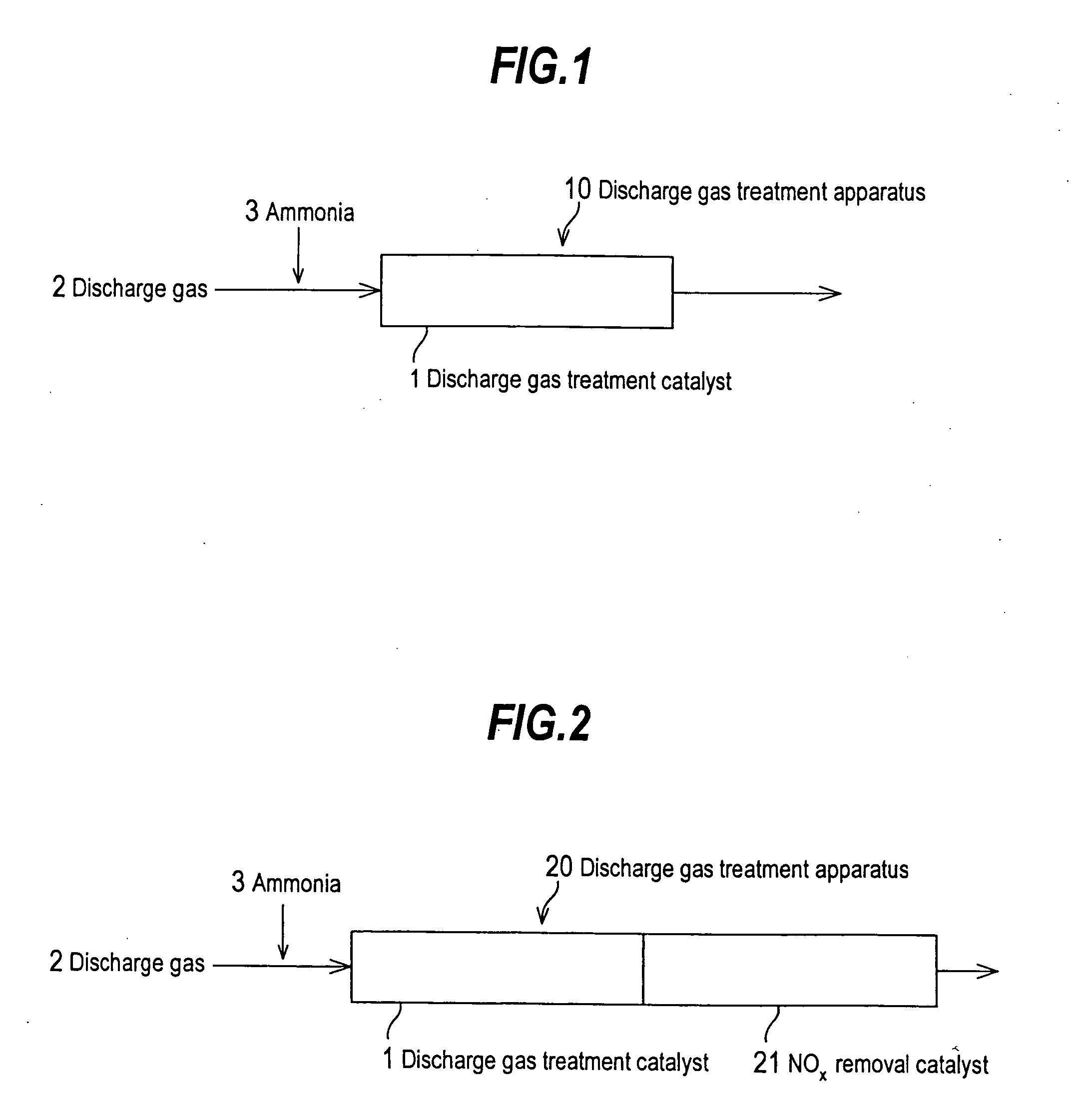Discharge gas treatment catalyst and method and apparatus for treating discharge gas
- Summary
- Abstract
- Description
- Claims
- Application Information
AI Technical Summary
Benefits of technology
Problems solved by technology
Method used
Image
Examples
example 1
[0032] A honeycomb-form catalyst (hereinafter referred to simply as honeycomb catalyst) formed of 100 parts by weight of titania (TiO2) and 9 parts of tungsten oxide (WO3) (TiO2—WO3 honeycomb catalyst) was immersed in a ruthenium chloride (RuCl3) solution (Ru concentration: 40 g / L) for one minute. Through impregnation caused by immersion, Ru (1 part) was carried by the titania-tungsten oxide catalyst (100 parts). The concentration of ruthenium chloride solution so that ruthenium (1 part) is carried by a honeycomb substrate (100 parts), when the titania-tungsten oxide honeycomb catalyst has a water content of 0.25 mL per 1 g of the catalyst, is calculated as follows. 0.01×(1 / 0.25)=0.04 g / mL=40 g / L
[0033] Thus, when a honeycomb catalyst (100 parts) is immersed for one minute in a ruthenium chloride (RuCl3) solution having an Ru concentration of 40 g / L, the honeycomb catalyst (100 parts) is impregnated with ruthenium (1 part).
[0034] The titania-tungsten oxide catalyst carrying...
example 2
[0038] The same slurry (No. 1) for catalyst coating as prepared in Catalyst preparation method 1 and the same honeycomb catalyst serving as a substrate as employed in Catalyst preparation method 1 were used. The set of immersion of the substrate in the slurry (No. 1), drying the substrate immersed in the slurry, and firing the dried substrate was performed twice, whereby the slurry (No. 1) was applied to the surface of the substrate at 200 g / m2. The thus-prepared honeycomb catalyst was employed as a discharge gas treatment catalyst (No. 2).
example 3
[0039] A honeycomb catalyst formed of 100 parts of titania (TiO2) and 20 parts of tungsten oxide (WO3) was immersed in a ruthenium chloride (RuCl3) solution. Through impregnation caused by immersion, Ru (1 part) was carried by the titania-tungsten oxide catalyst (100 parts). Subsequently, the titania-tungsten oxide catalyst carrying ruthenium was dried, followed by firing at 500° C. for five hours.
[0040] The thus-formed titania-tungsten oxide-ruthenium honeycomb catalyst was crushed by use of a crusher to a particle size of 10 mm or less. By use of a wet ball mill, the formed powder was further pulverized with water, to thereby prepare a slurry (No. 3) for catalyst coating.
[0041] In a manner similar to that employed in Catalyst preparation method 1, a honeycomb catalyst was produced, to thereby provide a discharge gas treatment catalyst (No. 3).
PUM
| Property | Measurement | Unit |
|---|---|---|
| Percent by mass | aaaaa | aaaaa |
| Percent by mass | aaaaa | aaaaa |
| Percent by mass | aaaaa | aaaaa |
Abstract
Description
Claims
Application Information
 Login to View More
Login to View More - R&D
- Intellectual Property
- Life Sciences
- Materials
- Tech Scout
- Unparalleled Data Quality
- Higher Quality Content
- 60% Fewer Hallucinations
Browse by: Latest US Patents, China's latest patents, Technical Efficacy Thesaurus, Application Domain, Technology Topic, Popular Technical Reports.
© 2025 PatSnap. All rights reserved.Legal|Privacy policy|Modern Slavery Act Transparency Statement|Sitemap|About US| Contact US: help@patsnap.com


